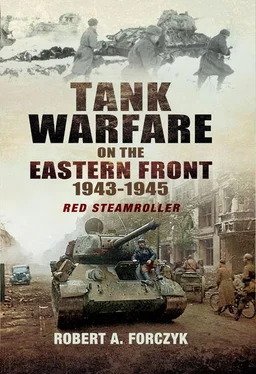On 9 January, Major Günther Tribukait, commander of Jäger-Bataillon 5, proposed one last desperate attempt to reach the remaining defenders in Velikiye Luki’s citadel: mounting his Jägers on the remaining panzers and SPWs and making a full-speed dash through the Soviet lines to reach the citadel. Unwilling to write the garrison off, von Chevallerie agreed even though it seemed a futile gesture. By afternoon, Tribukait assembled nine tanks from I./Pz. Regt. 15, 8 SPWs and 1 Sd. Kfz. 10/4 with a 2cm flak in a wooded area near the front. All the German vehicles were white-washed to blend in with the snow. Some infantrymen mounted on the tanks and others rode in the SPWs. At 1330 hours, Tribukait ordered the armour to advance in a wedge at high speed across the snow-covered terrain, followed by the halftracks. There was no artillery preparation and the Soviets were caught by surprise – these were not standard German panzer tactics. By the time the Soviets eventually began to react, the bulk of Tribukait’s formation had blitzed its way through the outer defences, losing some vehicles to anti-tank guns. In just an hour, the panzers reached the citadel, to the joy of the defenders. However, there was to be no rescue. A Soviet 76.2mm ZIS-3 anti-tank gun destroyed the trailing Pz III tank just as it entered the citadel gateway, trapping the other German tanks in the courtyard area. Soviet artillery then pounded the citadel, reducing the German panzers and SPWs to junk. Tribukait and the survivors joined the defenders. With no hope left, the German garrison attempted a breakout on the night of 15–16 January, but fewer than 200 troops succeeded in reaching German lines. {34}
The battles of Heeresgruppe Mitte against the Western and Kalinin Fronts in early 1943 have not made much of an impression on Eastern Front historiography to date, but these actions did impact the availability of armour on other fronts and influenced the coming summer campaigns. As if to highlight this point, on 1 March Model’s 9.Armee began Operation Büffel (Buffalo), the evacuation of the Rzhev salient. Within three weeks the evacuation was completed and had reduced the German front line by over 300km. Operation Büffel freed three Panzer-Divisionen to deploy elsewhere and provided Hitler with a sizeable operational reserve to use for either offensive or defensive purposes.
Relief of Leningrad: Operation Spark ( Iskra ), 12 January–19 March 1943
At the northern end of the line, the continuing siege of Leningrad dominated events. Heeresgruppe Nord’s 18.Armee (AOK 18) had the city under siege since September 1941. Inside the city, General-leytenant Leonid A. Govorov’s Leningrad Front was no longer starving and had recovered some of its combat capability. Outside the city, General Kirill A. Meretskov’s Volkhov Front made two attempts during 1942 to break through the German siege lines, but failed. The main area being fought over was the Siniavino corridor east of the Neva River, a swampy and heavily-wooded region measuring 15 x 15km that had no real roads. Although the two Soviet fronts were separated by less than 14km, the German XXVI Armeekorps had heavily fortified the Siniavino Corridor and the terrain greatly favored the defence. Hitler was determined that the Red Army not raise the siege of Leningrad and in order to reinforce the German defence in the Siniavino corridor, he had ordered that the very first Tiger tanks sent to the Eastern Front go to this sector. In September 1942, the 1./s. Pz. Abt. 502 had arrived by train and its Tigers were the first to see combat. By early January 1943, this single company – which still had seven Tigers and 16 Pz III tanks operational – was the main operational reserve for the XXVI Armeekorps. {35} In addition, the Sturmgeschütz-Abteilung 226 was stationed in the Siniavino corridor.
Meretskov’s plan for Operation Iskra (Spark) was similar to previous attempts: the Volkhov Front’s 2nd Shock Army would attack the Siniavino corridor from the east while simultaneously, the Leningrad Front’s 67th Army would cross the Neva River and attack the western side of the corridor. If the plan succeeded, the two Soviet fronts would link up somewhere in the corridor and a ground route opened to encircled Leningrad. The main weight of the attack came from the 2nd Shock Army in the east, which would attack with five rifle divisions and plenty of artillery. Although the 2nd Shock Army had 217 tanks (including 83 T-34 and about 20 KV-1) in its four tank brigades, one guards tank regiment and four OTBs, it could only employ company-size detachments of armour due to the marshy, restricted terrain. The 67th Army committed three tank brigades and two OTBs to the offensive, totalling another 222 tanks; altogether the Red Army committed 439 tanks to the offensive against no more than 50 German tanks and assault guns. {36}
At 0700 hours on 12 January 1943, Operation Iskra began with two hours and 20 minutes of artillery preparation on the German positions along the east bank of the Neva. Govorov’s Leningrad Front massed 144 guns and mortars per kilometre of front and fired three basic loads of ammunition – an almost unprecedented amount of artillery preparation for the Eastern Front so far. The temperature had fallen to -9 degrees F and the Neva was covered with snow and frozen solid, although artillery impacts broke the ice in places. Around 1150 hours, four Soviet rifle divisions from the 67th Army attempted to cross the 500-metre-wide frozen river, but the German defences were still intact and repulsed two division-size attacks with heavy losses. However, the other two Soviet rifle divisions, supported by 61 T-60 light tanks and 28 BA-10 armoured cars from Podpolkovnik Vladislav V. Khrustitsky’s 61st Tank Brigade, managed to seize a small bridgehead near Marino and they began to push eastward. The Soviet T-60 was not much of a tank but in this terrain, it was worth more than a road-bound Tiger since it could manoeuvre across the frozen marshland without bogging down. By dusk, Khrustitsky’s T-60s had penetrated 4km into the German positions and threatened to outflank the 96.Infanterie-Division. Meanwhile, Soviet engineers hastily prepared the crossing site near Marino – which had steep banks on the eastern side – enabling 25 T-34 medium tanks to cross before dusk. This was the first time that the Leningrad Front had managed to get a significant number of tanks across the Neva. In the east, the 2nd Shock Army attacked with four rifle divisions and small numbers of tanks after an even larger artillery preparation, but achieved only modest success.
The German XXVI Armeekorps regarded the 67th Army’s crossing of the Neva as the primary threat and reacted by committing most of the available armour to support a counter-attack by the 96.Infanterie-Division at 1615 hours on 13 January. Four Tigers under Oberleutnant Bodo von Gerdtell and 8 Pz III tanks moved up to support an attack by Grenadier-Regiment 284 against the Soviet 268th Rifle Division near Gorodok. The Tigers were camouflaged with whitewash, but were noisy enough to be heard at a distance. The Soviet infantrymen were nor expecting to see enemy tanks, much less Tigers, and many took to their heels, causing the Soviet division to reel back 2km. Govorov committed about 20 T-34s from the 152nd Tank Brigade into this sector to support his infantry, precipitating a close-quarter tank battle. Von Gerdtell’s Tigers did well, shooting up 12 T-34s but six or seven Pz IIIs were knocked out and their crews suffered 17 killed. Furthermore, the infantry battalions from the 96.Infanterie-Division were badly depleted, leaving the Tigers with minimal infantry support. While trying to defend this sector, von Gerdtell was killed the next day and 1./s. Pz. Abt. 502 was ground down under constant artillery fire.
Читать дальше








![John Stieber - Against the Odds - Survival on the Russian Front 1944-1945 [2nd Edition]](/books/405234/john-stieber-against-the-odds-survival-on-the-russian-front-1944-1945-2nd-edition-thumb.webp)



